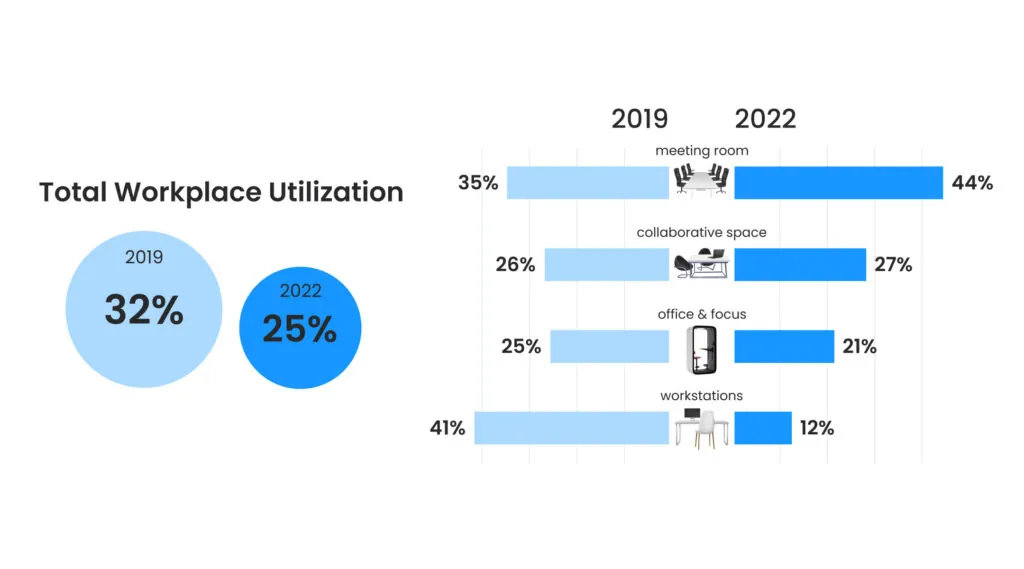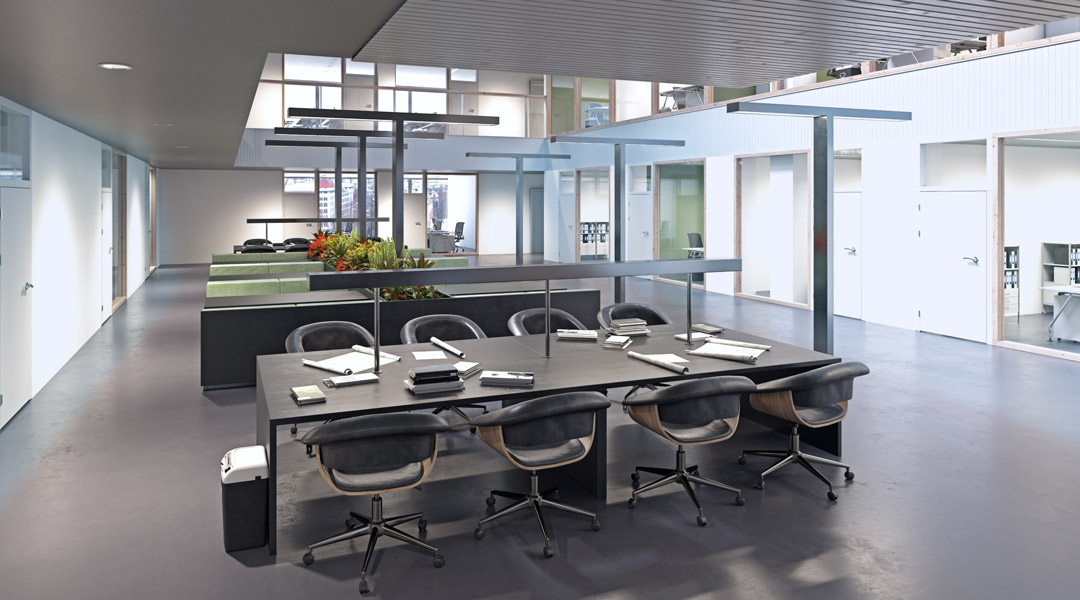
Right-Sizing your Portfolio with Peak Metrics
A new way of working is here to stay. What started as a pandemic-era necessity has rapidly become the norm in many industries, including many fortune 500 companies and global corporations. Studies have shown that 73% percent of employees say they need a better reason to go into the office than just company expectations. It’s not just about employees’ demands, though. 74% of all companies that planned on returning to the office also planned to offer some version of hybrid, work-from-home, or activity-based work accommodations.
But the adoption of work-from-home and hybrid work models has created a new problem for office managers, business owners, and stakeholders to solve: finding the right amount of space for their workforce when the office is suddenly no longer the only option for collaboration. Real estate is a company’s second greatest expense to people. We all know the 3-30-300 rule that JLL made an industry standard. This shift in the purpose of real estate makes us wonder- will these numbers change over the next 5 years? As companies downsize, will real estate no longer be the second expense, or at least by what proportion to people? Big-picture portfolio decisions like downsizing, opening satellite offices, or dimming floors in a building are all contributing to this rebalancing.
That’s why effective facilities management trends like right-sizing your portfolio need sophisticated data to better illustrate how your current space is used, and how it could be optimized.
3 Signs You Need To Right-Size Your Portfolio
There are real and obvious benefits to portfolio right-sizing, but many executives only begin to recognize them too late. When companies have leases to deal with, market proximity to reconsider, commute times to balance, and a host of other logistical problems baked into their real-estate portfolio, it can be tempting to look for solutions in other areas. However, companies experiencing the following problems may need to reconsider their space planning strategy before it’s too late.
1. A sea of empty desks
Maybe you’ve noticed that a strict one-to-one employee-to-desk ratio has resulted in lots of unoccupied and wasted space around the office. Maybe there are traffic jams in the hallway during certain times of the day, or a specific meeting room is full to capacity while others sit unused. Inefficient use of space is one of the hallmarks of a poorly sized property, and a demand for redistribution of space that may result in excess space.
2. Low Morale, decreased productivity, and/or high turnover when other variables remain unchanged
Workplace is one of the main factors affecting company culture. How a space is used, its aesthetics, accessibility, biophilia, and even how hot, cold, or bright it is all have a profound impact on the morale and productivity of your workforce. Space that is uncomfortable, inefficient, or poorly planned communicates to employees that their personal preference is a non-issue in the company’s priorities—a message that managers can’t afford to send in today’s landscape, where retention and productivity are increasingly driven by metrics like flexibility, personalization, and overall job satisfaction.
3. Unsustainable peaks and ebbs when it comes to occupancy
A big indicator that your company needs a real estate audit is whether or not your workspace can handle peak utilization times comfortably, and, vice versa, whether occupancy ebbs result in wasted space and capital in regards to utilities, lighting, ROI on square footage, etc. Essentially, peak occupancy refers to the times of the day, week, month, or even year when your office or workspace is most heavily trafficked. Recognizing and incorporating these times into your overall space utilization strategy has become even more important when implementing hybrid scheduling, as peak usage dictates the minimum amount of space needed to comfortably support your workforce. Establishing your company’s peak metric is crucial to developing a baseline utilization level on which your portfolio’s right-size rests.
What Are Peak Metrics?
Think of finding the right-size for your real estate portfolio as a problem to solve, and to solve a problem, you need data.
Peak utilization metrics tell you the maximum demand of a space, usually represented as a percentage—as in, the amount of space that is occupied out of the usable space available—and is applied over time. If you have a single peak event of 85% and discovered that was a rare instance like an all-hands meeting, we can throw out that anomaly. The average weekly peak is the number you need to figure out how the minimum amount of space your workforce needs to function.
Average weekly peak utilization may occur at 55%, meaning that is the maximum level of utilization your current space demands. Considering that the average utilization rates were roughly around 40% pre-pandemic, that’s not bad. You might find that peak utilization occurs at 55% on Thursday afternoons when two hybrid schedules overlap. This metric alone can give managers a baseline to address issues like scheduling, for example. By changing the scheduling arrangement, they might find that peak utilization now only occurs at 45%. If that trend is sustained, there might be a data-backed argument for downsizing the current real estate portfolio, as 55% of space is unused even during peak utilization. Alternatively, peak metrics, in this case, could also provide an incentive to, say, redesign the office layout around the space types that are in high demand.
How To Right-Size Your Space Portfolio With Peak Metrics
Once established, peak metrics allow for actionable insights into whether a space is meeting the needs of the company and allow for data-driven solutions to inefficiencies and wasted space. More than just helping corporate facilities managers and executives decide whether or not to downsize, right-sizing leverages utilization data points to use existing space better—but managers must ensure that they are operating under correct pretenses. There are a few things to know about right-sizing before you begin:
Understand Peak Metrics
Peak metrics and utilization come down to having the right data—but not all usage data is created equal. Workplace analytics systems like sign-in sheets, time cards, and RFID badges can produce simple time-in, time-out data points, which can be analyzed to produce a rudimentary utilization percentage. However, these data points only apply to the building as a whole and don’t offer any nuance beyond when people get to the office and when they leave.
Smart technology like occupancy sensors, on the other hand, can be strategically placed around the entire workspace, monitoring entire floors, counting how many people are using a conference room, or even areas as granular as individual workstations or phone rooms. With these kinds of intricate data sets, managers can observe usage trends over time, giving them a more complete picture of which spaces are more heavily trafficked, and which sit idol using up valuable resources like heating, lighting, and AC. R-Zero occupancy sensors can also sort usage data that corresponds to the time of the day, month, or even year, displaying trends in both the short and long term. Also, R-Zero’s anonymous sensors use thermal sensors to tell when someone is occupying a space, which means your workforce’s privacy is never compromised, like in the case of security cameras or image-based monitoring.
Identify Opportunities For Your Portfolio
Having utilization data then allows business owners and managers to identify opportunities for optimizing space and adjusting their portfolio. Your office’ particular peak metrics might indicate that utilization numbers are good, but your employees aren’t collaborating well. In this case, you might invest in more collaborative areas and meeting rooms around your office, as opposed to individual desks or workstations, as your workforce has enough space—just the wrong layout.
Perhaps you’ve identified that peak utilization rates are low ever since you’ve established a hybrid work schedule. If most of your workforce has a long commute from where they live to your primary office, you might consider downsizing your current space and opening smaller satellite offices in areas that are closer to your workforce. Identifying real estate opportunities comes down to having the correct real time data to base decisions on and knowing the needs and preferences of your workforce.
Executing A Right-Sizing Plan
Once you’ve established the kind of strategy that balances effective utilization and the needs of your employees, it’s important to communicate changes to your workforce clearly. Layout changes, workspace availability, and potential relocation can be big changes in a workplace and can be disruptive. This is especially true if changes are undertaken arbitrarily or with seeming indifference to employee preference, which can lead to poor employee retention, job dissatisfaction, and impacted productivity. Having current data for targeted points is one means of explaining to your workforce the kinds of factors that influenced your right-sizing strategy and the issues that the new plan is designed to address.
What Are The Benefits Of the Right-Sized Space Portfolio?
Considering the data-gathering, planning, and execution involved, right-sizing your portfolio can seem like a difficult undertaking, but it comes with real benefits to both your workforce and our bottom line. At its most basic, a right-sized portfolio is one that’s optimized for your business’s specific spatial needs, meaning that you’re not spending capital on unused space—but right-sizing isn’t just about having more or less space.
Right-sizing is about capitalizing on specific utilization trends to find the amount and type of space that best serves your workforce. Plenty of companies could cram desks together until they have 100% utilization, but the toll that overcrowding, workspace unavailability, and other symptoms of poor spatial planning takes on your workforce could actually result in decreased productivity—meaning that the increase in utilization actually costs your company in lost wages. And if we journey back to the top, we know that wages are a companies #1 expense by a factor of 10.
When properly planned and executed, a right-sized portfolio can lead to substantial ROI on leased or owned space, properly incentivized employees, more dynamic and agile utilization, and increased employee efficiency. This may even result in enough cost savings to drop real estate as a top 3 expense.
Even as businesses around the world adjust to a changing workplace environment and scheduling norms, with the right kind of data and planning, right-sizing should be seen as an opportunity for your company to get more out of the workspace while promoting a productive, collaborative office culture. If you’d like to learn more about supporting your right-sizing efforts with the necessary utilization data, R-Zero has you covered. Contact us to learn more about our occupancy sensors and how they can help you find the space that’s right for you.
More posts you might like
-
2022 Benchmark Data. Who Is Measuring What?
Hello Friends, Who ended 2022 where you thought you would? Well, many of our customers did not and some ended the year finding themselves in the middle of surprising new trends. We’d like to share with you some of our 2022 sensor-based Utilization Benchmark Data. If you are curious about any of these key findings, […]
-
Top 8 Essential Office Space Utilization Metrics & Their Applications
One thing we know for sure is that the future is uncertain. Instead of being stuck in a daze of wonder, real estate professionals are grounding their planning processes in data. So long as they have data to guide them, they can plan for hybrid work environments that are bound to change over time. Fortune […]
-
Allocation vs Utilization: Put Your Data in Action With Workplace Analytics!
If you’re a facility manager or otherwise deal with the business of organizing your office’s space, there are two terms you need to be familiar with: allocation and utilization. These terms are often used interchangeably, but they actually refer to very specific yet equally important aspects of creating a cost-effective and space-efficient workplace environment. Learning […]


